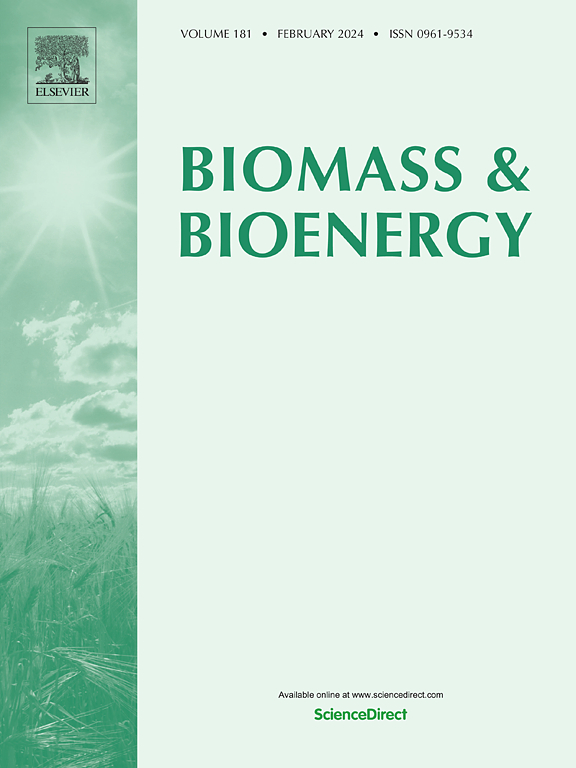Tailoring hydrophobic deep eutectic solvents for sustainable and high-efficiency recovery of organic acids and furan aldehydes from sugarcane bagasse hydrolysate
IF 5.8
2区 生物学
Q1 AGRICULTURAL ENGINEERING
引用次数: 0
Abstract
The valorization of sugarcane bagasse hydrolysate remains a critical challenge in sustainable biorefining, requiring green and efficient strategies to recover inhibitory by-products such as organic acids and furan aldehydes while adhering to circular economy principles. In this study, a hydrophobic deep eutectic solvent (HDES) composed of Aliquat 336 and 2-octanol (molar ratio is 3:1) was designed to address these challenges. Under optimized conditions (25 °C, organic/aqueous phase ratio is 3:1), the HDES exhibited outstanding extraction efficiencies of 87.36 % for acetic acid, 93.66 % for furfural, and 89.37 % for 5-hydroxymethylfurfural (5-HMF), surpassing most previously reported solvents. Additionally, almost completely recovery after NaOH regeneration, with sustained performance through 5 regeneration cycles, demonstrating exceptional structural stability and reusability. Comprehensive characterization using FT-IR, 1H NMR, TGA, and DSC confirmed the stability of HDES, while DFT calculations revealed that hydrogen bonding and van der Waals interactions plays key roles in the extraction mechanism. Notably, despite lower binding energies compared to acids, furans were preferentially extracted due to competitive extraction dynamics. This work not only advances solvent design for biomass hydrolysate detoxification but also bridges lab-scale innovation with industrial scalability, offering a sustainable pathway to transform agro-industrial waste into value-added resources and reinforce the green circular bioeconomy.

定制疏水深共晶溶剂,可持续和高效地回收有机酸和呋喃醛从蔗渣水解物
蔗渣水解物的增值仍然是可持续生物精制的一个关键挑战,需要绿色有效的策略来回收有机酸和呋喃醛等抑制副产物,同时坚持循环经济原则。在本研究中,设计了一种由Aliquat 336和2-辛醇(摩尔比为3:1)组成的疏水深共晶溶剂(HDES)来解决这些问题。在优化条件下(25°C,有机/水相比为3:1),HDES对乙酸、糠醛和5-羟甲基糠醛(5-HMF)的提取率分别为87.36%、93.66%和89.37%,超过了之前报道的大多数溶剂。此外,NaOH再生后几乎完全恢复,在5次再生循环中保持性能,表现出优异的结构稳定性和可重复使用性。FT-IR、1H NMR、TGA和DSC等综合表征证实了HDES的稳定性,而DFT计算表明,氢键和范德华相互作用在萃取机理中起关键作用。值得注意的是,尽管与酸相比,呋喃的结合能较低,但由于竞争萃取动力学,呋喃被优先萃取。这项工作不仅推进了生物质水解解毒溶剂的设计,而且将实验室规模的创新与工业可扩展性联系起来,为将农业工业废弃物转化为增值资源和加强绿色循环生物经济提供了一条可持续的途径。
本文章由计算机程序翻译,如有差异,请以英文原文为准。
求助全文
约1分钟内获得全文
求助全文
来源期刊

Biomass & Bioenergy
工程技术-能源与燃料
CiteScore
11.50
自引率
3.30%
发文量
258
审稿时长
60 days
期刊介绍:
Biomass & Bioenergy is an international journal publishing original research papers and short communications, review articles and case studies on biological resources, chemical and biological processes, and biomass products for new renewable sources of energy and materials.
The scope of the journal extends to the environmental, management and economic aspects of biomass and bioenergy.
Key areas covered by the journal:
• Biomass: sources, energy crop production processes, genetic improvements, composition. Please note that research on these biomass subjects must be linked directly to bioenergy generation.
• Biological Residues: residues/rests from agricultural production, forestry and plantations (palm, sugar etc), processing industries, and municipal sources (MSW). Papers on the use of biomass residues through innovative processes/technological novelty and/or consideration of feedstock/system sustainability (or unsustainability) are welcomed. However waste treatment processes and pollution control or mitigation which are only tangentially related to bioenergy are not in the scope of the journal, as they are more suited to publications in the environmental arena. Papers that describe conventional waste streams (ie well described in existing literature) that do not empirically address ''new'' added value from the process are not suitable for submission to the journal.
• Bioenergy Processes: fermentations, thermochemical conversions, liquid and gaseous fuels, and petrochemical substitutes
• Bioenergy Utilization: direct combustion, gasification, electricity production, chemical processes, and by-product remediation
• Biomass and the Environment: carbon cycle, the net energy efficiency of bioenergy systems, assessment of sustainability, and biodiversity issues.
 求助内容:
求助内容: 应助结果提醒方式:
应助结果提醒方式:


